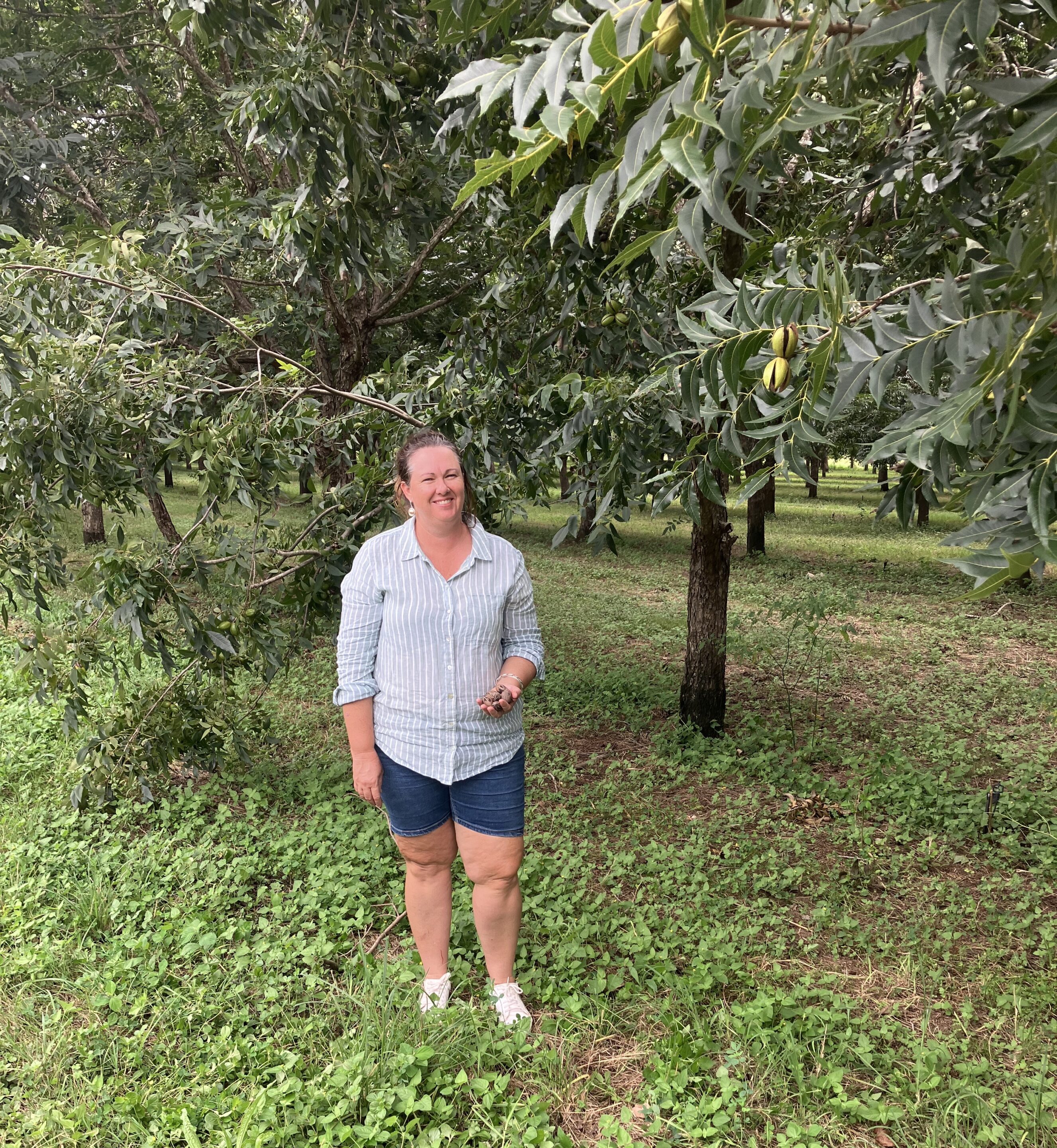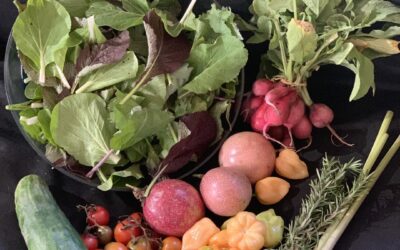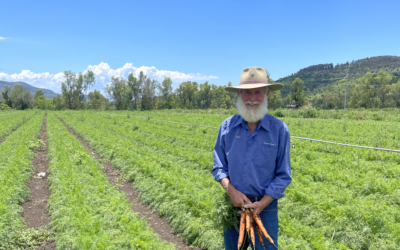As part of the QCWA Country Kitchens Meet a Farmer initiative, the Country Kitchens team recently spent some time at Lee’s Dragonfruit Plantation. Sue and Gary Lee are based just outside Rockhampton, Queensland. Sue has fond memories of organising play groups at the QCWA hall in Tully several years ago. This interview has come at a perfect time with the QCWA gearing up to begin their 2023 Primary Product – dragon fruit. The Country Kitchens team have developed several dragon fruit related resources, community activities and recipes for QCWA members and facilitators.
Dragon fruit is a tropical fruit produced by several species of cactus that are native to Mexico, Central and South America. They are also grown in southeast Asia, Israel and Australia. Pitaya is the name given to the fruit produced by the cactus, but it is also commonly known as dragon fruit. Recognised for its unique and bright appearance, dragon fruit acquired its name because the oval shaped fruit and green, pointy external ‘scales’ are thought to represent a dragon or dragon egg.
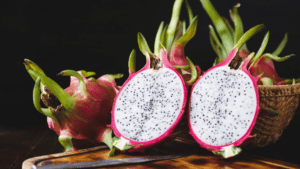
Dragon fruit is classified as a fruit and therefore is a core food according to the Australian Guide to Healthy Eating. Fruits provide vitamins, minerals, dietary fibre and many hundreds of phytonutrients. Dragon fruit is rich in fibre, vitamin C and antioxidants. One serve of dragon fruit is about ½ of a large fruit or 1 cup in total. This is equivalent to one of the recommended two serves of fruit we should consume every day.
Dragon fruit farming is a relatively new venture for Sue and Gary.
“We went to Vietnam and saw the fruit there and we loved it. We decided to start growing [dragon fruit] from cuttings just for ourselves as a hobby. We realized that there was a lot of interest, so we started selling them at markets. As community interest and sales increased, we grew more plants.”
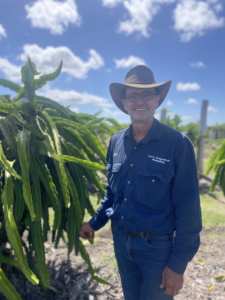
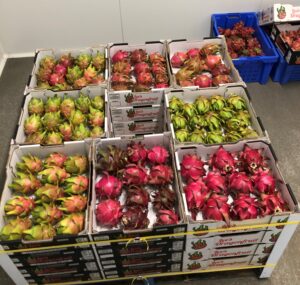
Although dragon fruit is their main production, they are also increasing their crops of other tropical fruits including guava, passionfruit, finger lime and jack fruit. Sue and Gary are quite the busy duo. While working the farm, Gary also works in mining and Sue runs a daycare from home. When it comes to the farm work, Sue says,“I love being able to work outside.” Gary elaborates,
“I like working outside with no real distractions. I find it relaxing. Work is only that because you don’t really enjoy it. Our farm work is an interest, and we find it satisfying and very enjoyable for most parts. Sue and I enjoy doing things together in the business, working outside together in particular. I enjoy the reward of seeing really good quality large fruit as it shows the results of our hard work.”
Dragon fruit has increased in popularity since the 1970’s when it was first reportedly grown in Australia. Australia now has around 40 000 dragon fruit plants. “Dragon fruit farming is very labour intense”. Sue explains that there is always something to do. From planting, trimming, pollinating, and protecting from pests, it keeps the couple very busy. “We also have to put up nets to protect the plants from fruit fly, foxes, and birds.”
Outlining the farming process, Sue shares that “cuttings are dried out for 7 days in a cardboard box, so they start to root. We plant them straight into the ground with a hardwood or concrete post to prop them up.” Sue and Gary wait for around nine months until the cuttings start to produce flowers. Sue explained that once the plants are in flower, the pollination begins.
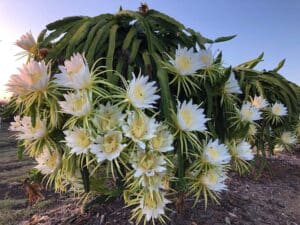
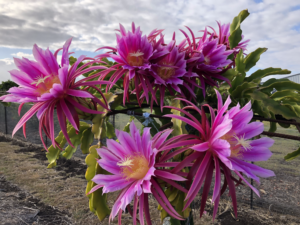
“You need a red and white dragon fruit plant for cross pollination. We have some self-pollinating plants, but we manually pollinate to get them across the line. Bees also help with pollination.”
Gary has been creative with techniques to improve production of fruit.
“We use a small Ryobi vacuum with a special home-made nozzle to suction the pollen out. We put it in the freezer to brush on [the dragon fruit flowers] later.”
The dragon fruit flowers open in the evening until early morning. Gary uses this time to brush the pollen into the open flowers. They estimate that it takes around 30-40 days to produce fruit from the flower before they hand pick it. But the work doesn’t stop there.
“Each year we trim all the plants because they are very fast growing. We use a chainsaw to go along each row and manually prune all the dragon fruit plants.”
Gary loves to eat the yellow dragon fruit straight from the skin. Sue loves the vibrant American beauty, lemonade, and yellow dragon fruit. We learn that the yellow dragon fruit has the sweetest flavour and were lucky enough to receive a sample to taste.
When asked about her favourite dragon fruit recipe, Sue had one word – “smoothies!” She says, “the standard white and yellow are better for tropical type smoothies.” She uses the purple dragon fruit for milk and yoghurt-based smoothies with other fruit such as mulberries, mango, and frozen berries. She also gets the day care children involved making simple recipes with dragon fruit and serving fruit smoothies.
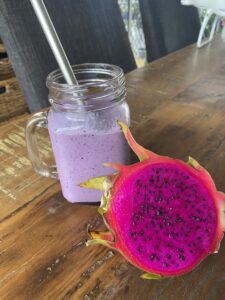
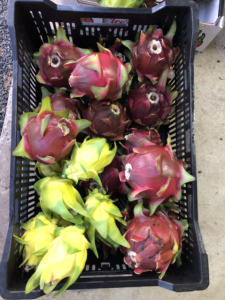
Touching on food waste, Sue explained “we can’t sell the smaller dragon fruit so that ends up being pig food.” Gary explains that “smaller fruit can also be cut, pulp removed and then dried to a soft apricot type consistency.” Sue and Gary also freeze some of the extra dragon fruit to use in smoothies.
The couple feel that QCWA could support farmers by “including recipes in cookbooks, alongside the recipes introduce farmers with pictures of them and introduce their produce and tell people where their fruit is coming from.” As well as explaining the farming process, Sue also feels that the produce could be used in recipes and at community events to promote it.
Head to our recipe page to find our delicious Country Kitchens dragon fruit recipes. Access our 2023 Primary Product – Dragon Fruit resources by clicking here.
Empowering women through education and health is a priority for the Queensland Country Women’s Association (QCWA). The QCWA Country Kitchens program, funded by the Queensland Government through Health and Wellbeing Queensland, supports Queenslanders to adopt healthier lifestyles.

